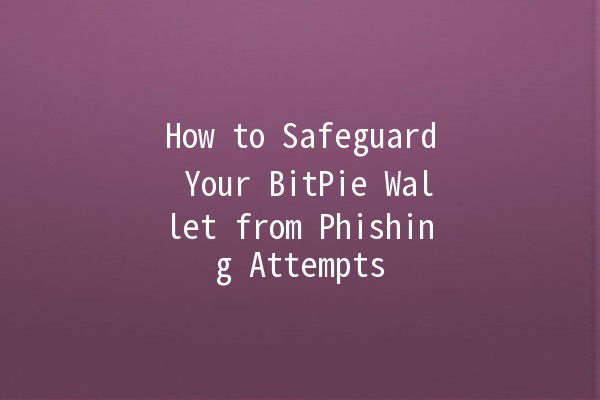
In the world of cryptocurrency, security is paramount. As digital assets continue to gain popularity, the risk of phishing attacks has surged, targeting unwary users. BitPie Wallet, renowned for its multicurrency support and userfriendly interface, is not immune to such threats. This article delves into practical techniques and strategies that users can adopt to shield their BitPie Wallet from phishing attempts. We'll also provide insights into recognizing potential pitfalls and enhancing overall digital security.
Understanding Phishing Attacks
Phishing is a method used by cybercriminals to deceive individuals into providing personal information or access to their accounts. Attackers often employ fraudulent emails, websites, or even messages that impersonate legitimate entities. Understanding how these attacks work is the first step in protecting oneself.

Email Phishing: Fraudulent emails appear to come from trusted sources.
Spear Phishing: Targeted attacks tailored for specific individuals or organizations.
Clone Phishing: A legitimate email that has been cloned to replace a legitimate attachment or link with a malicious one.
Whaling: Phishing attacks directed at highprofile individuals such as CEOs or executives.
Recognizing these methods allows you to take preventative measures.
Practical Tips to Avoid Phishing When Using BitPie Wallet
One of the most crucial steps in avoiding phishing attacks is ensuring that you are visiting the correct website.
Application Example:
Before entering your credentials on BitPie Wallet, always doublecheck the URL in your browser’s address bar. Phishing sites often use URLs that are similar but slightly altered, such as “bitpiewallet.com” instead of the legitimate “bitpie.com”. Bookmarking the official site will help ensure you navigate to the correct location every time.
TwoFactor Authentication adds an additional layer of security to your wallet.
Application Example:
Enabling 2FA on your BitPie Wallet account means that even if someone obtains your password, they would still need a second form of verification, such as a code sent to your mobile device, to access your account. Use authentication apps like Google Authenticator or Authy instead of SMS for enhanced security.
Public WiFi networks can expose you to various cyber threats.
Application Example:
When accessing your BitPie Wallet, avoid using public WiFi. If you must use it, employ a VPN (Virtual Private Network) to encrypt your connection. This minimizes the risk of having your data intercepted by hackers on the same network.
Keeping your software updated is critical in protecting against vulnerabilities.
Application Example:
Ensure that both your BitPie Wallet app and your device’s operating system are uptodate. Developers frequently release updates to patch security flaws. Make it a habit to check for updates regularly and enable autoupdates when available.
Being able to identify phishing emails can considerably reduce the chance of falling victim.
Application Example:
Phishing emails often contain grammatical errors, generic greetings like “Dear User,” or ask for sensitive information. Always scrutinize the sender’s email address and look for any suspicious links. Legitimate communication from BitPie Wallet will not ask for your password or other sensitive information via email.
Regularly reviewing account activity can help you spot unauthorized transactions.
Application Example:
Log in to your BitPie Wallet frequently and check for any transactions you did not initiate. If you notice any suspicious activity, change your password immediately and notify BitPie Wallet's support team.
Frequently Asked Questions (FAQs)
If you suspect a phishing attempt, first avoid clicking any links or downloading attachments. Change your password for the affected account, enable 2FA if you haven’t done so already, and report the phishing attempt to BitPie Wallet.
No, phishing attempts can occur through various mediums, including social media, text messages (SMS), and even phone calls. Always verify the source before interacting with any message requesting sensitive information.
BitPie Wallet uses industrystandard security protocols and frequently updates their software to ensure maximum protection. They encourage users to enable 2FA and promote awareness of phishing tactics.
Yes, many antivirus programs offer realtime protection against phishing websites and can alert you if you’re about to visit a known malicious site. Ensure your antivirus software is always uptodate.
While BitPie Wallet employs robust security measures, it’s essential to practice personal security habits. Always verify transactions, enable 2FA, and stay vigilant against potential phishing schemes.
No, using unique passwords for different accounts is crucial. If one account is compromised, having unique passwords prevents attackers from gaining access to your other accounts.
al Thoughts
By implementing these strategies, BitPie Wallet users can significantly reduce their risk of falling victim to phishing attacks. Awareness and vigilance are key components of digital security. Remember that no security measure is foolproof, but the combination of good habits and reliable security practices can protect your digital assets effectively. Stay informed, stay secure, and enjoy a safer cryptocurrency experience.

